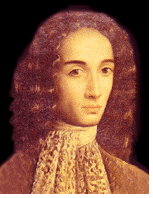...Best of Sicily
presents... Best of Sicily Magazine. ... Dedicated to Sicilian art, culture, history, people, places and all things Sicilian. |
by Beniamino Inserra | ||
Magazine Index Best of Sicily Arts & Culture Fashion Food & Wine History & Society About Us Travel Faqs Contact Map of Sicily |
In those far-off days any native child with musical talent was almost immediately assigned to work within the confines of the ubiquitous Roman Catholic Church. Musicians, composers and singers were not yet considered autonomous artists who operated as free agents of their talents but rather were in the same social caste as tailors, carpenters or barbers; in a word: "artisans." All in the service of either a local feudal aristocrat or "Holy Mother Church." Such was the case with young Alessandro. He spent his earliest years at Palermo and Naples. Because he had talent he was sent to Rome in 1672 to study with the noted post-Renaissance musician Carissimi and it is there that he married at the tender age of eighteen. It seems that marriage was lucky for young Alessandro because he was almost immediately made master of the chapel choir of the church of San Giacomo degli Incurabili. Besides the traditional oratorios he began to compose operas and chamber cantatas. Scarlatti was devoted to combining musical instruments to the sound of the human voice. All for the glory of God. One of his "theatrical plays set to music" was titled Gli Equivoci del Sembiante. This early opus came to the attention of none other than Queen Christina of Sweden who was then in voluntary exile in Rome. The Queen was so pleased she appointed him her own maestro di cappella in 1680. Four years later Scarlatti was chosen for the same honour at the court of the viceroy in Naples while his younger sibling Francesco was made first violinist. In the elegant sophisticated Naples of the Bourbons the Scarlattis flourished. Alessandro's operas were appreciated and performed with regularity and aristocratic success in the twenty year period of his Neapolitan sojourn. Unfortunately, European events in the early eighteenth century began to encroach on this Sicilian darling of the Neapolitan nobility. Because of war and economic dislocation due to the War of the Spanish Succession, Scarlatti decided to emigrate north to Florence. In the elegant Tuscan city he hoped to perform the same services for the De Medici family as he had for earlier patrons. Alas even here brutal economics and difficult political problems abounded and the disappointed composer again returned to Rome where there was at least a semblance of stability due to the power of the Papacy and the Pope. At the Apostolic Basilica of Santa Maria Maggiore (Saint Mary Major) in the heart of the Eternal City he became assistant musical director. Though it was something of a demotion, he was able to parlay this job into a sinecure for himself and his growing son Domenico, also a musician. At this moment secular operas were banned (temporarily) so Alessandro turned his talent to sacred oratorio with some success. In the first decade of the eighteenth century he served both the members of the Catholic Curia and the Papal Aristocracy of Rome. For his efforts he was elected to the prestigious Arcadian Academy of Rome in 1706 along with Archangelo Corelli, an erstwhile rival. Though he ventured north to Venice for his great passion --the opera-- he was again forced to retreat to the Eternal City because of professional problems. His Venetian operas failed. He was promoted in 1707 to the top musical position at Santa Maria but preferred to return to Naples to work this time for the Austrian viceroy resident in the city. From 1708 until his death in 1725 he remained in his beloved capital of the Kingdom of Naples, venturing out of it every so often for special occasions. One of these was his elevation to the Roman nobility by Pope Clement XI and the presentation of his last opera in 1721-- La Griselda Scarlatti Senior was a master technician and diligent artist who can rightly be appreciated for his skill in the style of music we call "Baroque." He was not one of the original geniuses but rather a secondary light in the Baroque-Classical firmament. And yet even that position is not to be deprecated. About the Author: Beniamino Inserra is Best of Sicily's resident opera critic and the author of numerous hard-copy articles. | |
Top of Page |
 In the musical galaxy of baroque and classical composers the Scarlatti father and son duo must admittedly be assigned to the rank of "lesser suns." Yet, for discerning aficionados of such glorious music the two must indeed be considered and appreciated, even if they can never challenge the fame of Handel, Vivaldi, Corelli nor Bach. However, Palermo can look with pride upon its native son Alessandro Scarlatti (originally "Scarlata") who was born in the Sicilian capital during the spring of 1660.
In the musical galaxy of baroque and classical composers the Scarlatti father and son duo must admittedly be assigned to the rank of "lesser suns." Yet, for discerning aficionados of such glorious music the two must indeed be considered and appreciated, even if they can never challenge the fame of Handel, Vivaldi, Corelli nor Bach. However, Palermo can look with pride upon its native son Alessandro Scarlatti (originally "Scarlata") who was born in the Sicilian capital during the spring of 1660.